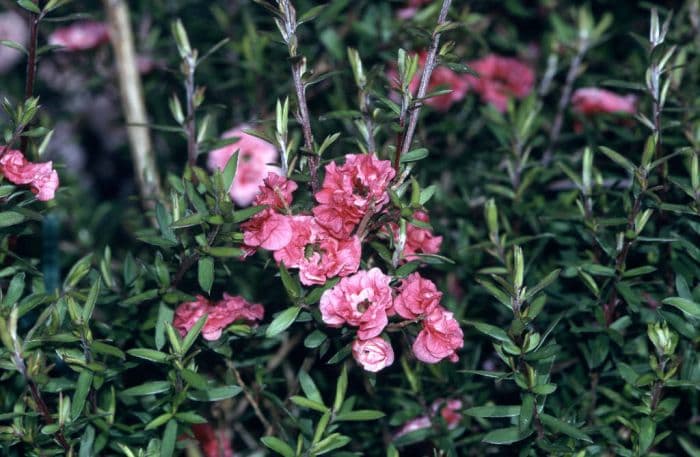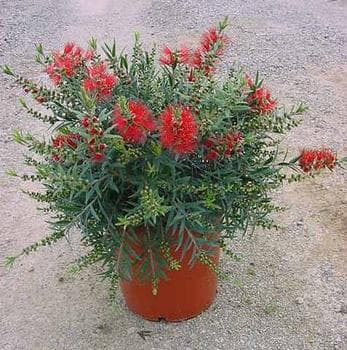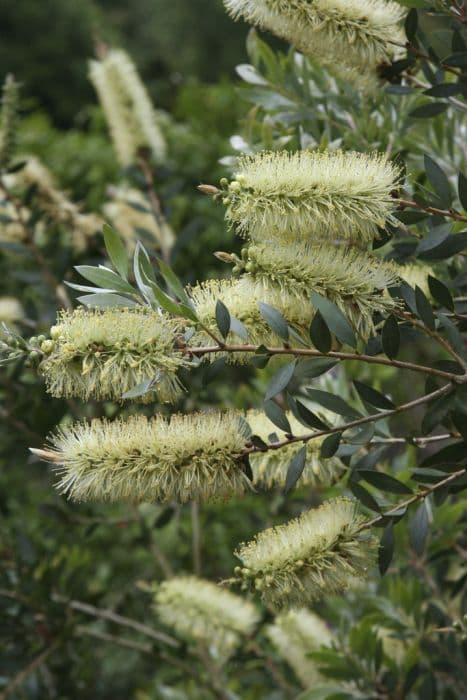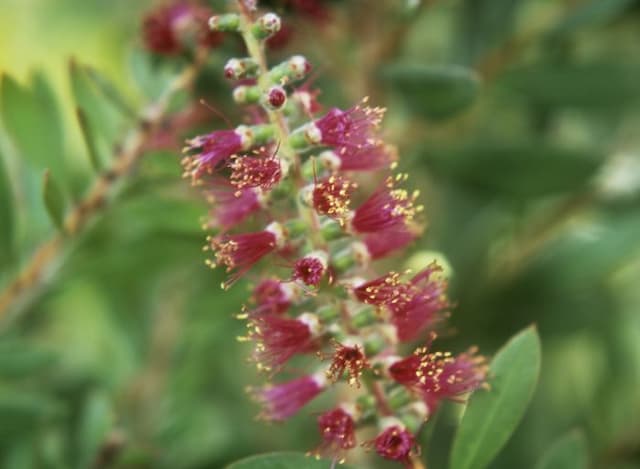Manuka Leptospermum scoparium 'Red Damask' (d)

ABOUT
The Red Damask is a striking plant admired for its vibrant beauty. It boasts a dense, bushy form and is adorned with small, needle-like foliage that is often dark green in color. The plant truly shines when it bursts into color with its deep red, double flowers that have a frilly appearance, resembling small roses. These exquisite blooms are richly hued, providing a dramatic contrast against the dark foliage, and become a focal point in any garden when they make their appearance. The flowers not only add a splash of color but are also a magnet for pollinators like bees, which are drawn to their attractive form and possible nectar. When not in bloom, the plant maintains a lush, evergreen presence, with its foliage offering a year-round display of greenery.
About this plant
 Names
NamesSynonyms
Manuka, Red Damask Tea Tree, New Zealand Tea Tree, Red Damask Manuka.
Common names
Leptospermum scoparium var. incanum, Leptospermum scoparium var. grandiflorum, Leptospermum scoparium var. rotundifolium, Leptospermum grandiflorum, Leptospermum rotundifolium, Leptospermum scoparium var. vulgare, Leptospermum vulgare.
 Toxicity
ToxicityTo humans
The Manuka plant is not known for being toxic to humans. There are no well-documented cases of poisoning from ingesting parts of the Leptospermum scoparium 'Red Damask' or Manuka plant. While consuming plant parts is generally not recommended unless the plant is known to be edible, there is no specific information suggesting that the Manuka causes adverse effects when ingested by humans.
To pets
The Manuka plant is also not known to be toxic to pets. There are no common reports of poisoning in pets, such as dogs and cats, from ingesting parts of the Leptospermum scoparium 'Red Damask' or Manuka plant. It is generally safe around pets, and there should be no symptoms of poisoning expected from animal ingestion of this particular plant. However, as with any non-food plant, monitoring your pets around it and preventing them from consuming large amounts may be advisable to avoid any possible stomach upset.
 Characteristics
CharacteristicsLife cycle
Perennials
Foliage type
Evergreen
Color of leaves
Green
Flower color
Red
Height
4-6 feet (1.2-1.8 meters)
Spread
4-6 feet (1.2-1.8 meters)
Plant type
Shrub
Hardiness zones
9
Native area
Australia New Zealand
Benefits
 General Benefits
General Benefits- Attractive Aesthetics: Offers vibrant red flowers that enhance the visual appeal of gardens and landscapes.
- Pollinator-Friendly: Attracts bees and butterflies, which are beneficial for pollination in the garden.
- Drought Tolerance: Once established, it is drought-resistant, making it suitable for xeriscaping and low-water landscapes.
- Easy Maintenance: Requires minimal pruning and care, making it ideal for gardeners who prefer low-maintenance plants.
- Erosion Control: The dense growth habit helps prevent soil erosion on slopes and banks.
- Evergreen Foliage: Maintains its leaves throughout the year, providing consistent greenery and structure in the garden.
- Versatile Landscaping: Can be used as a hedge, specimen plant, or in mass plantings for various design effects.
- Container Planting: Suitable for growing in pots, which is convenient for patios, balconies, and small spaces.
 Medical Properties
Medical Properties- Antibacterial: Leptospermum scoparium, commonly known as Manuka, has demonstrated antibacterial properties, particularly due to a compound called methylglyoxal (MGO).
- Antiviral: There is some research indicating it may have antiviral effects, but more studies are needed for conclusive evidence.
- Anti-inflammatory: Manuka honey, sourced from this plant, is often touted for its anti-inflammatory properties, which may help reduce inflammation when used topically.
- Wound healing: Manuka honey has been used in wound care for its potential to promote healing and reduce the risk of infection.
- Skin health: Topical products containing Manuka extract may support skin health, thanks to its antibacterial and anti-inflammatory properties.
 Air-purifying Qualities
Air-purifying QualitiesThis plant is not specifically known for air purifying qualities.
 Other Uses
Other Uses- The common name for Leptospermum scoparium 'Red Damask' is New Zealand Tea Tree, and its wood can be used for tool handles because it is hard and dense, providing durability.
- The bark of the New Zealand Tea Tree can be used as mulch in gardens to suppress weeds and retain soil moisture due to its slow decomposition rate.
- The nectar from the flowers is sometimes used in creating uniquely flavored honey when bees forage from these plants, known for its characteristic taste.
- Due to its compact growth habit, New Zealand Tea Tree can be trained as a bonsai, making it a popular choice for enthusiasts of this art form.
- As an ornamental plant, the New Zealand Tea Tree can be incorporated into windbreaks or hedges in coastal areas because of its resistance to salty winds.
- The essential oils extracted from the New Zealand Tea Tree can be used in aromatherapy for its calming and pleasant scent, although not medically proven.
- The strong wood from the New Zealand Tea Tree can be turned into small wooden crafts such as ornaments, showcasing its appealing grain patterns.
- Its distinctive flowers and long flowering season make the New Zealand Tea Tree a valuable plant for attracting pollinators like bees and butterflies to gardens.
- Dried New Zealand Tea Tree branches and foliage can be used to create natural decorative wreaths and flower arrangements.
- The dense and compact foliage of the New Zealand Tea Tree can be used as a natural sound barrier in urban gardens to dampen noise pollution.
Interesting Facts
 Feng Shui
Feng ShuiThe New Zealand Tea Tree is not used in Feng Shui practice.
 Zodiac Sign Compitability
Zodiac Sign CompitabilityThe New Zealand Tea Tree is not used in astrology practice.
 Plant Symbolism
Plant Symbolism- Healing: Commonly known as Manuka, this plant is recognized for its medicinal properties, particularly its antibacterial effects due to the honey produced from its nectar.
- Resilience: Manuka is known for its ability to thrive in tough environmental conditions, symbolizing resilience and adaptability.
- Protection: Traditionally, Manuka was used by indigenous Maori for protective purposes in various rituals, representing shelter and defensive qualities.
- Purity: The white and pink blossoms are often associated with purity and tranquility, reflecting the plant's pristine natural habitats.
 Water
WaterThe New Zealand Tea Tree, or Leptospermum scoparium 'Red Damask', prefers to be kept evenly moist but not waterlogged. In general, watering once a week with about 1-2 gallons of water is sufficient, adjusting for your climate and the size of your plant. Ensure the top inch of soil dries out before watering again to prevent root rot. During the growing season, in spring and summer, you may need to water more frequently, especially if the weather is particularly hot or dry. In the cooler months, reduce watering to every other week or when the soil is dry to the touch.
 Light
LightThe New Zealand Tea Tree thrives in full sun, which means it requires at least 6 hours of direct sunlight each day. Place it in a location where it receives ample light, like a south-facing window or unobstructed outdoor space. It can tolerate partial shade, but its flowering may be reduced in less than ideal light conditions.
 Temperature
TemperatureThe New Zealand Tea Tree is hardy and can withstand a range of temperatures; however, it prefers a mild to warm climate. It can survive minimum temperatures down to 20 degrees Fahrenheit, but ideally, it should be kept in conditions that remain between 50-75 degrees Fahrenheit. Extreme cold or frost can damage the plant, so provide protection or move it indoors if such conditions are expected.
 Pruning
PruningPruning the New Zealand Tea Tree helps maintain its shape, encourage denser growth, and remove any dead or diseased wood. It's best to prune in late winter or early spring before new growth begins. Remove no more than one-third of the plant's size during a pruning session to avoid stress. Deadheading, or removing spent flowers, can also stimulate new flowering.
 Cleaning
CleaningAs needed
 Soil
SoilNew Zealand Tea Tree or Manuka prefers well-draining soil with a slightly acidic pH between 5.5 to 7.5. A good soil mix consists of equal parts peat, perlite, and pine bark fines or a commercial potting mix blended with additional perlite and compost to improve drainage.
 Repotting
RepottingNew Zealand Tea Tree should be repotted every 2 to 3 years, or when it outgrows its current container, to provide fresh nutrients and room for growth.
 Humidity & Misting
Humidity & MistingNew Zealand Tea Tree thrives in moderate to low humidity levels and can cope with the dry air found in most home environments.
 Suitable locations
Suitable locationsIndoor
Provide bright light, well-draining soil.
Outdoor
Full sun, protect from harsh frost.
Hardiness zone
9-11 USDA
 Life cycle
Life cycleLeptospermum scoparium 'Red Damask', commonly known as 'Red Damask' New Zealand Tea Tree, begins its life cycle as a seed, which requires well-draining soil and sunlight to germinate. Once the seed germinates, it develops into a seedling, which then grows into a young plant with characteristic needle-like foliage and eventually forms a woody stem. As it matures, 'Red Damask' produces vibrant red double flowers, typically in spring or early summer, attracting pollinators such as bees. After pollination, seed capsules form and mature, eventually releasing seeds to start the next generation. The main growth period is during the warmer months, with the plant entering a period of dormancy in colder months. The plant can live for many years, developing into a dense shrub up to 2 meters tall, and may require occasional pruning to maintain shape and encourage flowering.
 Propogation
PropogationPropogation time
Spring-Early Summer
Propogation: The most popular method of propagating the Manuka or New Zealand Tea Tree, which is the common name for Leptospermum scoparium 'Red Damask', is through semi-hardwood cuttings. This procedure is best undertaken during late summer to early autumn. First, you'll need to select a healthy semi-hardwood stem, which is a portion of the plant's stem that has matured partially after the current year's growth. Cut a piece of stem about 2 to 6 inches (5 to 15 centimeters) long, ensuring there are several leaf nodes present. Remove the lower leaves and dip the cut end into a rooting hormone powder to increase the chances of successful rooting. The cutting should then be planted in a well-draining potting mix, making sure at least one node is below the surface as this is where new roots will emerge from. Keep the cuttings in a warm, humid environment with indirect sunlight, and maintain the moisture of the potting mix without letting it become waterlogged. Roots usually develop within a few weeks.









